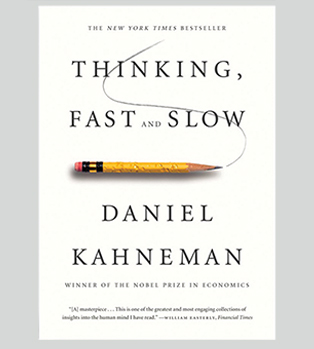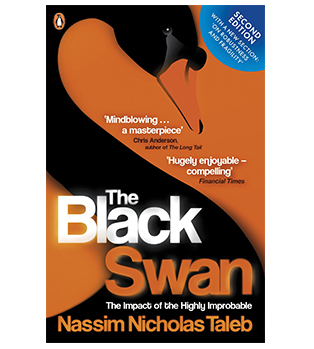Through a review of three wonderful books, The Art of Not Giving A F*ck, Think Fast & Slow, and Black Swan, the columnist gives interesting insights into how we can deal with adversity, thinking bias and management prejudice.
As narrated by Sukumar Rajagopal in his Facebook Live series

Mark Mason’s The Subtle Art of Not Giving a F*ck urges us to step away from self-help guides which tell us to think positive and find happiness, and become more adept at dealing with advertsity. The author banks on academic research and witty one-liners and anecdotes to show its readers that once we embrace reality, our fears, faults and uncertainties, we live a more courageous, confident, meaningful and centered life.
During a discussion a few months ago, my co-founder Kumaran and I decided to put together a pitch deck for our startup and the task fell on me. I researched the internet, picked out good templates and understood the typical questions we had to tackle – what is the business plan, who is the customer, how do we make money, how do we scale and more. These questions had a paralyzing effect on me and for several weeks I didn’t even start. I tried my usual techniques to beat the procrastination loop – forming habits, setting deadline and the like but they didn’t work. I realized this was because the cognitive cost of doing such a task was very high.
Incidentally, around the same time, I started reading the book; The Subtle Art of Not Giving a F*** by Mark Manson; a book recommended to me by my Twitter friend Ruchi Bhatia. I am grateful to her for that.
In his book, Manson makes an interesting observation. When we think about an action, we think of it as preceded by motivation which is preceded by inspiration and so on in a linear fashion. In actuality, he says these – inspiration, motivation and action – are a loop. We could, in fact, get started with action, which he calls the “do something” principle, which will then provide the initial bit of motivation and inspiration, and the momentum will build and over time we can get the entire task done.
I was impressed with this approach and decided to test the idea. I opened a blank powerpoint deck and jotted down all the thoughts that were swirling in my head about the investor deck. Lo and behold! Within a few weeks, I had a good pitch deck ready and both (my co-founder and I) were convinced about it. Later, we showed it to a few investor friends and they found it interesting too and shared a lot of valubale feedback with us.
After this episode, I was curious to know more about the author, Mark Manson. I was surprised to learn that he’s only in his early 30s and wrote the book a couple of years ago. While I’ve quoted just a small extract from the book, which proved to be a wonderful lesson for me, there are several other interesting insights in this book and I would strongly recommend each of you to read it.
How can we overcome a bias that makes us do things without a second thought or without prior research? The answer to this question lies in Daniel Kahneman’s book titled ‘Think Fast & Slow’, where the author indicates that the brain has two systems, which work in tandem, to create inherent bias and ‘belief blind spots’ which affect our decision making. His solution? Get exposed to varied belief systems which may lessen the number of blind spots and improve thinking
I once wondered, why do I do stupid things, like getting angry with near & dear ones or selling valuable stock without proper research? When I asked around, the typical answers I received, traced back to the left brain-right brain theory or low emotional intelligence. Unsatisfied, I dug deeper into these questions and came across a piece of research which piqued my interest. The study indicated that there are 200 cognitive biases that afflict us, which may explain many of the seemingly stupid things we do. But hey! How do we overcome 200 biases? When will that journey even end!
Enter, Daniel Kahneman. Kahneman received a Nobel Prize in Economics for creating an entirely new field in behavioral economics which turned the subject on its head. He wrote about it in this book, titled Think Fast & Slow. The central idea conveyed by the book is that the brain has two systems, System 1 which acts fast and System 2, which is more deliberate and slow.
Let’s take an example. A father and son go for a drive and meet with a severe accident. The father escapes unhurt but the sun is critically injured. The father rushes the son to the hospital for an emergency surgery. But, when he reaches the operating theater, the surgeon takes one look at the son and says “I can’t operate, because he’s my son”.

How is this possible?
If you couldn’t think of the correct answer, it’s because you have a subconscious belief that a surgeon has to be a male. We call these belief blind spots. If you got the correct answer that the surgeon is the mother, you are still missing another possible answer which is also due to belief blindspots. Belief blind spots are caused because System 1 and System 2 work hand-in-hand. So, the solution to overcome this is not to spend more time on a similar line of thought. We need to think more deeply about assumptions we may not be aware of, which is understandably very hard. One way to beat this, is diversity. When different belief systems come into play, the blind spots may also be different and help solve problems better.

Nicholas Naseem Taleb’s Black Swan is an insightful book that takes a deep dive into how cumulative advantage/ disadvantage, extremism and mediocre-ism can change the way we work and motivate ourselves
Admit it. All of us hate performance reviews. After every annual review, we get an A, B or C rating. Even in those companies where the management doesn’t rate its employee performance, the classification exists in their mind.
What happens is, eventually, the employees come to be known to the management as an A, B or C player. For a few years after I became a manager, even I followed this concept. Luckily, I had a life changing experience which changed my thinking. I found out that many people deemed C players by others were turning out to be excellent performers. This opened my mind and I rejected the ABC player concept, albeit with a lot of disagreement from others.
That’s when I came across Black Swan, a book written by Nicholas Naseem Taleb. Taleb classifies all the professions in the world into Mediocristan & Extremistan, where the suffix ‘Stan’ refers to place. Mediocristan is safe and predictable, whereas, Extremistan is a place with extreme risk and rewards; unpredictable extreme events he calls “Black Swans”, like the Subprime crisis or the Dotcom meltdown. In fact, Taleb goes one step further, to reveal that Extremistan bestows cumulative advantage. For example, the more runs Tendulkar scores, the more opportunities he gets to score further and the cycle goes on.
To understand this better, let’s take an example. Think of a successful person who inspires you.
PAUSE.
Anyone we call successful is likely from Extremistan professions; like artists, musicians, authors, actors or sportspersons. They make money based on the value/impact they deliver. Let’s say, today, a young cricketer decides to become the next Tendulkar. No one can give him a predictable path to get there, because the path is laden with unpredictability. For every Tendulkar and Superstar Rajini there is, there are thousands of other cricketers and actors out there who struggle to make a living. So, the A, B and C player concept makes some sense here. Less than 5 per cent of the humanity works in these jobs.
The rest of the 95 per cent falls into this category Taleb calls, Mediocristan. In Mediocristan, people make money based on the hours worked or a monthly salary. In other words, it’s low risk-low reward. Think teachers, software engineers, managers, doctors and more.
Taleb’s mathematical model behind Mediocristan shows that a mere 30 per cent improvement in performance can move someone from C to B or B to A. Also, there is no cumulative advantage here – last year’s A performance or C performance doesn’t give someone an unfair advantage or unfair disadvantage this year. So, anyone can deliver an A grade performance with some hard work.
Therefore, when organizations go by performance ratings, they mistakenly view the ABC labeling as a permanent personality attribute. What happens, as a result? Due to a psychological phenomenon called Pygmalion Effect or Power of Expectations, people do what we expect them to – people branded as C players will likely continue to deliver only a C performance. If this ABC Player thinking gets entrenched over time in the minds of the entire management team and staff, there will be a significant negative impact on the organization in the long term.
So, do we really need ratings if there’s a possibility of improvement in an employee over a period of time? I leave you to ponder on that question.
